The Effects of ElectroMagnetic Frequencies (EMF) on the Blood and Biological Terrain
Updated: May 21, 2023
Live and Dried Blood Analysis with EMF Exposure

Challenge:
4-subject study Live blood analysis [1.2.3.4] involves visual examination of freshly-drawn capillary blood of subjects that is put between a glass cover slip and microscope slide and viewed using an optical microscope with video enhancement. It shows images of the various types of blood cells in their native state and plasma bodies as small as chylomicrons. It is regarded as an important assessment of the biological terrain of the body by holistic health practitioners.
The test requires either a dark-field or phase-contrast microscope and a high contrast videocamera attached to it. The magnification with video enhancement and projection on a monitor ranges up to 20,000X.
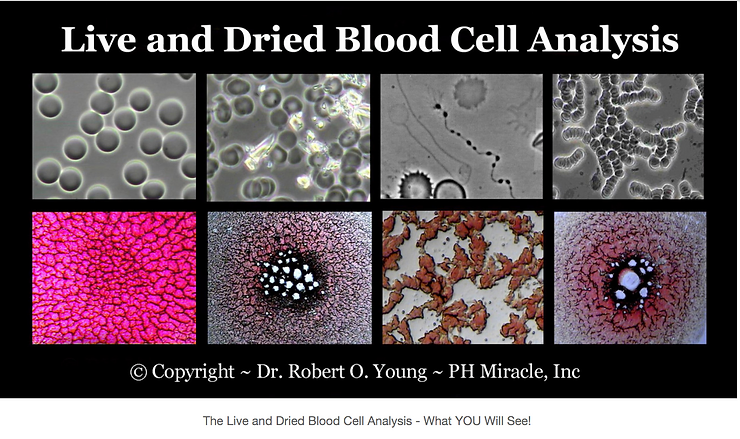
A remarkably detailed view of live, unstained blood is thus obtained, inaccessible by any other means. The size and shape of the cells, their morphological stability over time, states of agglutination, the presence of cell wall-deficient microbes[5] and the motility of white blood cells are just some of the parameters observed in video footage and microphotographs.
Normal healthy fasting blood shows free-floating round-shaped red blood cells interspersed with an occasional white blood cell, and clear plasma with only a few chylomicrons. There are many morphological deviations from the normal state that are associated with nutritional, oxidative, pH, and EMF and other stressors that tend to disrupt the normal biological terrain.
Dried blood analysis, also called the OST or Oxidative Stress Test[6], is a procedure in which a droplet of freshly drawn capillary blood is left to sit between 20 seconds to 1 minute on the fingertip from which it is drawn, and then pressed onto a glass microscope slide in 8 sequential layers. It is then left uncovered to clot and dry. The resulting fibrin web is examined under a bright-field optical microscope under 10 to 20x magnification, and the patterns noted.
The accumulation of clinical research data over years shows empirically how the blood pictures relate to oxidative stress and other health issues. In particular, the presence of clear or whitish polymerized protein puddles (PPPs) seen in a thin layer of hard-clotted blood indicate oxidative stress. The number and position of PPPs in the layer, as well as their shape and size are evaluated in the test, as well as other parameters. [2001, Clarus Products International, LLC] [7]
Normal healthy blood produces a fibrin web that is continuous and without PPPs, and it appears a uniform pinkish-red. These blood tests are often used by holistic health practitioners to assess the overall health of the biological terrain and the nutritional status of patients. They are not, however, recognized yet in conventional medicine. There is, nonetheless, a wealth of empirical data that correlates the test results with quantitative blood testing and clinical manifestations.
The tests are particularly useful to examine the effects of oxidative and other types of stress on the body at the cellular level, and they are often done in tandem.
In the initial study conducted by Robert O. Young, Ph.D., a microbiologist, 3 hypotheses were tested:
(1) How does 8 hours exposure to ambient low-level EMF pollution in the workplace affect the blood morphology of normal healthy human subjects as measured by live and dry blood analyses?
(2) Does wearing the QLink during exposure to ambient low-level EMF affect the same blood tests of these subjects?
(3) What is the subjective experience of the subjects after wearing the QLink for the first 72 hours?
Both live and dried blood analyses of volunteers under the following experimental conditions were performed:
(1) baseline: without known EMF stressors present;
(2) EMF challenge: 8 hours’ exposure to ambient low-level EMF in the workplace;
(3) EMF challenge while wearing a QLink: between 8 and 24 hours’ exposure per day for 3 days to low-level ambient EMF stress while knowingly wearing a QLink pendant for 72 hours continuously.
Four female subjects, 20 to 30 years old, were the subjects in the study. Neither the subjects nor experimenters were blinded as to the experimental conditions of testing in this study. The subjects lived and worked in London, England, where they had exposure to EMF pollution as computer operators, video editors, and account managers.
Moreover, they all reported having stressful occupations with long work hours. All were told not to change anything in their lifestyle during the study except for wearing the QLink pendant.
Subjects were not informed of the results of their blood testing during the study.
The results are as follows for the 3 experimental conditions as defined above.
Subject I:
(1) Baseline testing showed blood cell disorganization with the presence of cell wall-deficient microbial forms in the live blood test; the OST showed many PPPs throughout indicating abnormal blood clotting profile.
(2) The results of EMF challenge showed an increase in the apparent numbers of cell wall-deficient microbes in the live blood test; more PPPs were observed in the OST, as well as a dark center, which has been empirically correlated with bowel congestion.
(3) The results of EMF challenge while wearing a QLink showed results that were much improved: a normal live blood profile with fewer microbial forms; the OST revealed a normal pattern. The subject also reported that she was sleeping better, felt less stressed, and did not experience her reoccurring headaches while wearing the QLink.
Subject II:
(1) Baseline testing showed blood cell disorganization with some colloid precipitation and crystals in the plasma, as well as some cell wall-deficient microbial forms in the live blood test. The OST showed many PPPs throughout, indicating abnormal clotting associated with cellular disturbance and disorganization, and a dark, 2001 Clarus Products International, LLC. [8] central core that is indicative of bowel congestion.
(2) The results of EMF challenge showed an increase in the colloid forms and crystals in the live blood test. The OST revealed larger PPPs scattered throughout and the same dark center associated with bowel congestion.
(3) The results of EMF challenge while wearing a QLink showed normal results in the live blood analysis. The OST shows a normal pattern, with only a single PPP observed. The subject also reported feeling less stress and better bowel elimination while wearing the QLink.
Subject III:
(1) Baseline testing showed blood cell disorganization with high levels of precipitated colloids in the live blood test. See Figure 6(a). The OST showed PPPs in the center of the clot, which are associated with cellular disturbance and the possibility of bowel congestion. See Figure 6(b).
(2) The results of EMF challenge showed the same types of disturbances with red blood cell aggregation and stacking in the live blood cell test. See Figure 7(a). The OST showed even more PPPs that previously, indicating more severe tissue stress and congestion in the bowel. See Figure 7(b).
(3) The results of EMF challenge while wearing a QLink showed little aggregation of red blood cells and a reduction in colloid deposits. See Figure 8(a).
The OST showed a normal pattern. See Figure 8(b).
The subject also reported feeling less stress, less sugar cravings, and experiencing normal bowel elimination while wearing the QLink. (a) (b) Figure 6.
Subject III – (a) Live red blood cell photos before EMF exposure (no QLink). (b) Dried blood cell photos before EMF exposure (no QLink). 2001 Clarus Products International, LLC. [9] (a) (b) Figure 7.
Subject III – (a) Live red blood cell photos after EMF exposure (no QLink). (b) Dried blood cell photos after EMF exposure (no QLink). (a) (b) Figure 8.
Subject III – (a) Live red blood cell photos with EMF exposure (with QLink). (b) Dried blood cell photos with EMF exposure (with QLink).
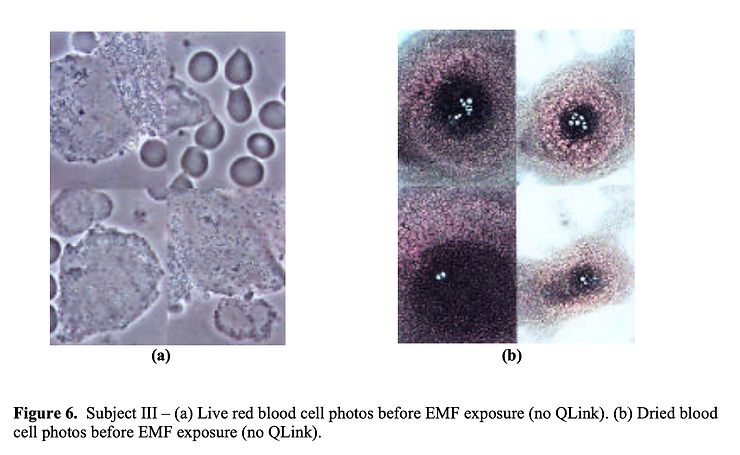

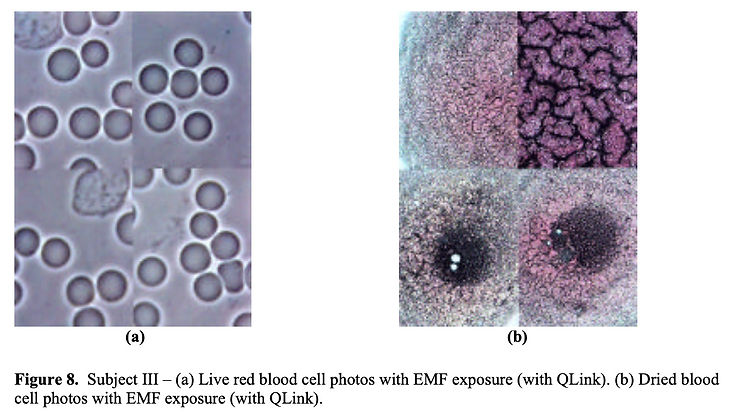
Subject IV:
(1) Baseline testing showed normal red blood cell organization, normal active white blood cells, and a small amount of cell-wall deficient microbial forms as well as crystals. The OST showed many PPPs throughout the clot, indicating cellular disturbance and disorganization throughout the body.
(2) The results of EMF challenge showed a number of crenated (wrinkled) red blood cells. The OST showed many PPPs, 2001 Clarus Products International, LLC. [ and a darker center of the blood clot, suggesting bowel congestion.
(3) The results of EMF challenge while wearing a QLink showed a normal blood profile in the live blood test, with round and separate red blood cells and actively motile white blood cells, without microbial forms. The OST showed a normal pattern. The subject also reported feeling less stressed and not experiencing digestive sensitivity or bowel congestion while wearing the QLink.
The conclusions drawn from this study are:
(1) the stress from 8 hours’ exposure to ambient low-level EMF in the workplace can be observed in the blood, and the live and dry blood cell tests record changes such as cellular disorganization and clotting dysfunction;
(2) the negative changes seen in blood from exposure to EMF stress can be overcome by wearing the QLink pendant for at least 72 hours; in some cases, the change was so dramatic, that the blood was improved over the control baseline condition;
(3) all 4 of the subjects reported experiencing an increase in energy and less stress. II.
Controlled Pilot Study Using Live and Dried Blood Analysis: 8-subjects
A subsequent study was conducted by Robert O. Young, Ph.D., which was a double-blind controlled trial involving 20 volunteers.

The hypotheses tested were the following:
(1) Does the QLink show an improvement at the level of the biological terrain and blood morphology as monitored via live and dry blood analyses of subjects who were exposed to low-level ambient EMF stress for 72 hours?
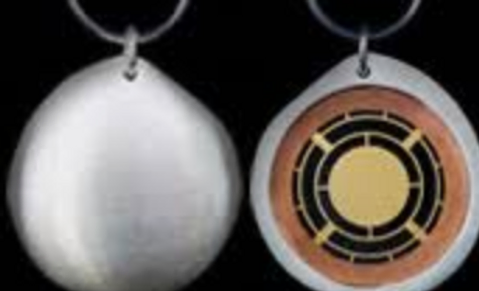
(2) What do subjects report subjectively about the status of their physical and mental health and well being after wearing the QLink for 72 hours?
Four of the 20 subjects were disqualified from the beginning and dismissed from the study, because they had prior knowledge of Clarus, and in fact, were already wearing the QLink. The remaining 16 subjects, which consisted of adult males and females ranging in age from 35 to 60, were assigned randomly into 2 groups of 8 each, Group A and Group B.
Group A wore a sham device (control) and Group B wore the real QLink, although this was not revealed until the end of the study.
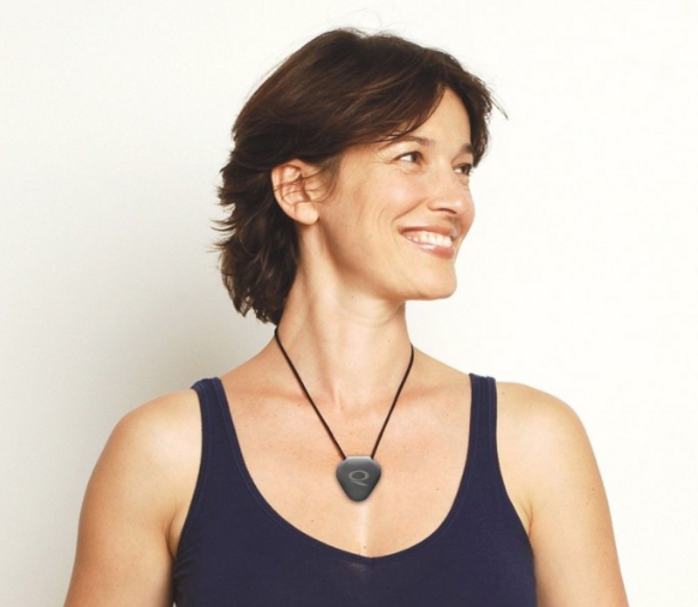
Both groups wore QLink-type pendants, but only the pendants of the experimental group, B, had been activated. The sham devices of control group, A, were inactive pendants that were otherwise physically identical to the active QLink pendants.
All 16 subjects were exposed to normal everyday EMF pollution associated with cell phones, fluorescent lighting, computers, power lines, and other office and work-related equipment, in addition to other stressors that were held constant during the duration of the study.
They were told not to change anything in their lifestyle except for wearing the pendants. In addition, the subjects were exposed to low level ambient EMF pollution of daily life.
Live blood and dry blood (OST) analyses were conducted on each subject as follows:
(1) control condition, before wearing the device; and
(2) experimental condition, after wearing the device as a pendant for 3 full days, day and night. Blood was drawn from a finger prick and immediately observed under a video-enhanced optical microscope [2001 Clarus Products International, LLC] assembly as described above. Blood cell images were recorded by microphotography.
The Results
Group A: Sham QLink
Subject I:
(1) The control live blood test showed some morphological disorganization in the red blood cells and the presence of cell wall-deficient microbial forms. See Figures 9(a) & 9(b).
The OST showed PPPs center and off-center in the blood clot associated with cellular disturbance and disorganization. See Figures 10(a) & 10(b).
The center of the clot was darker then normal, which is associated with bowel congestion. (2) The experimental live blood test showed no change from the control test. See Figure 9(c).
The OST showed a slightly different pattern than the control [See Figures 11(a) & 11(b)], with a greater number of PPPs in the middle of the clot, which is indicative of health challenges in the chest cavity. The other abnormalities observed in the control OST remained the same.
The subject remarked that he experienced the same health conditions as before. (a) (b) (c) Figure 9.
Subject I, Group A—Sham QLink device: (a) and (b) Control live red blood cell photos without QLink A. (c) Live red blood cell photo with QLink A. No apparent changes in the live red blood cell photos between the control and QLink A. [2001 Clarus Products International, LLC. 26 (a) (b) Figure 10.
Subject I, Group A –Sham Device: (a) and (b) Control dried blood cell photos without QLink A. (a) (b) Figure 11.
Subject I, Group A –Sham device: (a) and (b) Dried blood cell photos with QLink A after approximately 72 hours.
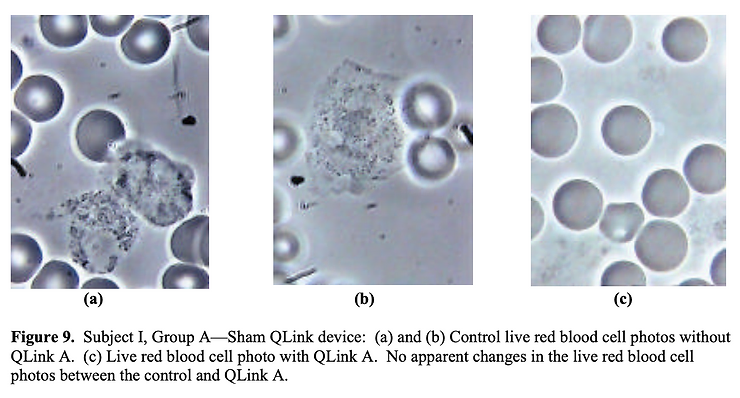
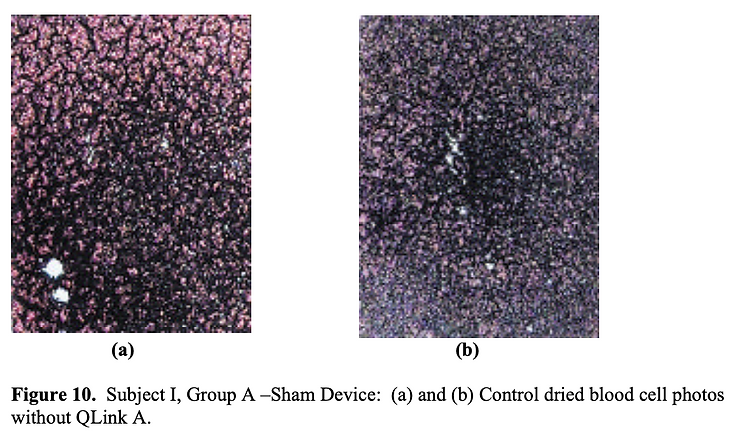

Subject II:
(1) The control live blood test showed stacking of red blood cells. The OST showed a normal pattern, except that the darkened color in the central zone indicated challenges in the center of the body.
(2) The experimental live blood test showed stacked red blood cells, and crystals were also present. The OST revealed the same pattern and color abnormality as the control. No changes in health were noted by the subject.
Subject III:
(1) The control live blood test showed crystals and stacking of red blood cells. The OST revealed a dark color in the center of the clot, which is indicative of congestion in the center of the body or the bowel in particular. Several PPPs were observed in and near the center, which suggest challenges to the bowel and reproductive system.
(2) The experimental live blood test showed the same pattern, with a propensity [2001 Clarus Products International, LLC.] for red blood cell stacking and the presence of crystals. The OST revealed the same pattern and color abnormality as the control. The subject indicated that he experienced the same health conditions as before.
Subject IV:
(1) The control live blood test showed red blood cell stacking. The OST showed a normal pattern, except for the center, which was dark and had PPPs, indicative of challenges to the bowel and reproductive system.
(2) The experimental live blood test was unchanged. The OST was unchanged. The subject indicated that he experienced the same health conditions as before.
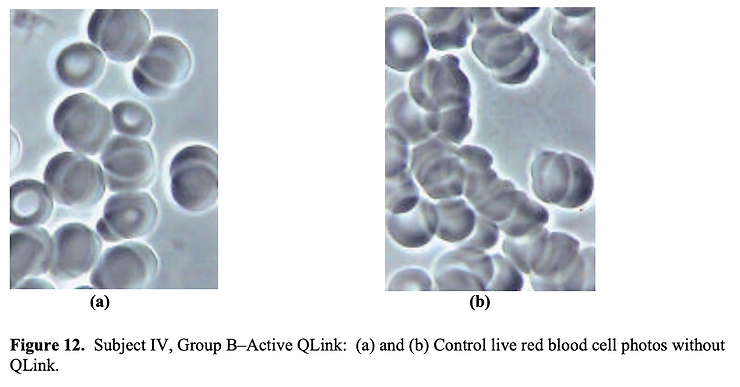

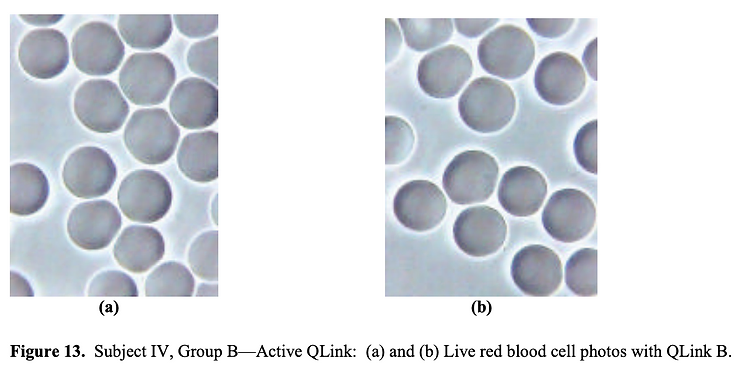
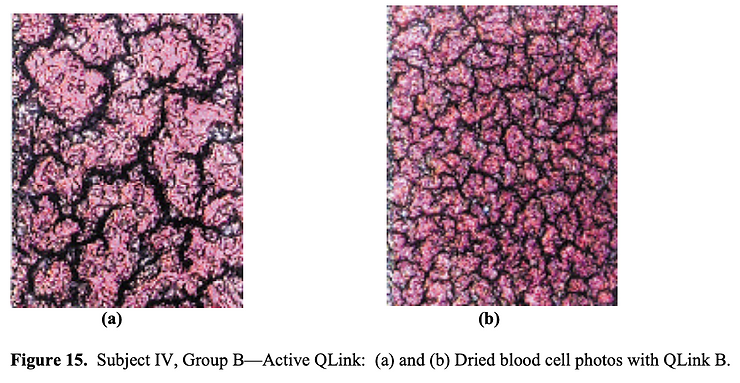
Subject V:
(1) The control live blood test showed red blood cell stacking and some crystals. The OST showed a normal pattern, except that the center was dark and PPPs were present, suggesting challenges in the bowel and reproductive systems.
(2) The experimental live blood test showed the same results as previously. The OST revealed the same results as well. The subject reported the same health challenges as before.
Subject VI:
(1) The control live blood test showed irregularly shaped red blood cells, colloid precipitates, and cell wall-deficient microbial forms present. The OST revealed many PPPs throughout the clot, indicating cellular disturbance and disorganization.
(2) The experimental live blood test showed no change, nor did the OST. The subject indicated that the aches and pains in her back and legs were still present.
Subject VII:
(1) The control live blood test showed stacked red blood cells. The OST revealed a normal healthy profile.
(2) The experimental live blood test showed no change, nor did the OST. The subject reported no difference in his mental or bodily function.
Subject VIII:
(1) The control live blood test showed stacked red blood cells. The OST showed a normal clot with a dark center and central PPPs, indicating challenges to the bowel and reproductive system.
(2) The experimental live blood test showed no change, nor did the OST. The subject reported the same disturbances to digestion as before.
Group B: Active QLink
Subject I:
(1) The control live blood test showed irregularly shaped red blood cells that suggest iron deficiency.
The OST showed many PPPs throughout the clot, indicative of cellular disturbance and disorganization.
(2) The experimental live blood test shows normal round red blood cells.
The OST shows a normal healthy clotting profile with much less PPPs present. The subject reports an increase in energy while wearing the QLink-B pendant.
Subject II:
(1) The control live blood test showed irregularly shaped red blood cells and the presence of crystals and colloid precipitates in the plasma. Some red blood cells appeared to be parasitized with cell wall-deficient microbes, and these were also present in the plasma.
The OST revealed many PPPs in excess of 40 microns throughout the clot, indicating cellular disturbance and disorganization.
(2) The experimental live blood test showed normal, rounded, free-flowing red blood cells, and no microbial forms present. [2001 Clarus Products International, LLC]
The OST was more normal with small and fewer PPPs. The subject reported an increase in energy, a reduction in light-headedness, and no headaches after wearing the QLink-B.
Subject III:
(1) The control live blood test showed irregularly shaped red blood cells, platelet aggregation, cell wall-deficient microbial forms, and some crystals in the plasma.
The OST revealed some PPPs in excess of 40 microns throughout the middle of the clot, indicating cellular disturbance and disorganization, which is indicative of health challenges in the middle of the body or chest cavity.
(2) The experimental live blood test showed normal, rounded, free-flowing red blood cells, and there was no indication of colloidal or microbial aggregates.
The OST showed a normal profile without PPPs. The subject reported that the congestion in his throat and lungs cleared while wearing the QLink-B.
Subject IV:
(1) The control live blood test showed irregularly shaped red blood cells with a tendency toward aggregation, and a moderate level of cell wall-deficient microbial forms. [See Figures 12 (a) & (b)]
The OST showed several PPPs around 10 microns throughout the center of the clot that is associated with adrenal and psychological stress, as well as one large PPP at the center of the conglomerate, which is associated with a challenge to the male reproductive system. [See Figures 14 (a) & (b)]
(2) The experimental live blood test revealed normal rounded red blood cells that appear separate and free-flowing, with no indication of microbial forms. [See Figures 13 (a) & (b)]
The OST revealed a normal profile with no PPPs. [See Figures 15 (a) & (b)]
The subject indicated that he experienced increased energy and less inflammation while wearing the QLink-B. (a) (b) Figure 12
Subject IV, Group B–Active QLink: (a) and (b) Control live red blood cell photos without QLink. „2001 Clarus Products International, LLC. 26 (a) (b) Figure 13
Subject IV, Group B—Active QLink: (a) and (b) Live red blood cell photos with QLink B. (a) (b) Figure 14
Subject IV, Group B—Active QLink: (a) and (b) Control dried blood cell photos without QLink B. [2001 Clarus Products International, LLC] [9] (a) (b) Figure 15. Subject IV, Group B—Active QLink: (a) and (b) Dried blood cell photos with QLink B.
Subject V:
(1) The control live blood test showed irregularly shaped RBCs and some cell wall-deficient microbial forms in the plasma. The OST revealed a single 30-micron PPP just off center of the clot, which is associated with a challenge in the pancreas, liver, and/or kidneys.
(2) The experimental live blood test showed normal rounded red blood cells that appeared separate and free-flowing, with no indication of cell wall-deficient microbial forms. The OST revealed a normal profile, and the large central PPP had reduced to 10 microns. The subject reported that he felt no physical or psychological difference while wearing the QLink-B.
Subject VI:
(1) The control live blood test showed irregularly shaped red blood cells with a tendency to aggregate and stack, as well as a moderate level of cell wall-deficient microbial forms and colloidal precipitates in the plasma. The OST revealed a substantial number of PPPs ranging from 10 – 40 microns in the center of the clot, indicative of adrenal and psychological stress, in addition to 2 large PPPs just off center that are suggestive of challenges in the pancreas, liver, and/or kidneys.
(2) The experimental live blood test showed normal rounded red blood cells that appear separate and free-flowing, and no indication of colloidal matter or microbial forms in the plasma. The OST revealed a normal profile, with much fewer and smaller PPPs. The subject reported increased energy and less sugar cravings while wearing the QLink-B.
Subject VII:
(1) The control live blood test showed irregularly shaped red blood cells with a rouleau or stacking condition, and a moderate level of cell wall-deficient microbial forms in the plasma. The OST revealed PPPs throughout the central zone of the clot, indicative of adrenal stress, lack of exercise, and psychological stress. In addition, two large PPPs were in the center of the clot, which are associated with challenges to the bowel and reproductive systems. Finally, the central zone of the clot was dark, which is associated with bowel congestion.
(2) The experimental live blood test showed normal rounded red blood cells that are separate and free-flowing, and no indication of cell wall deficient microbial forms in the plasma. The OST revealed a normal profile and color. [2001 Clarus Products International, LLC]
The PPPs were reduced in size and number. The subject reported increased energy and less flatulence while wearing QLink-B.
Subject VIII:
(1) The control live blood test showed irregularly shaped red blood cells with a tendency to aggregate and stack, as well as a moderate level of cell wall-deficient microbial forms in the plasma. The OST revealed many PPPs ranging over 40 microns throughout the clot, which is associated with cellular disturbance and disorganization.
(2) The experimental live blood test showed normal, rounded, free-flowing red blood cells without stickiness or tendency to stack, and no indication of any microbial forms.
The OST revealed a normal profile, with much fewer and much smaller PPPs. The subject reported experiencing an overall feeling of good health. The conclusions from this controlled pilot study are as follows.
Conclusions
In 8 out of 8 subjects in Group A, there was little or no difference observed in the results of the live and dry blood tests before and after wearing the sham QLink for 72 hours. In addition, all 8 subjects wearing the sham device reported few or no significant improvements in energy level, well being, or physiological function. On the other hand, in 8 out of 8 subjects in Group B, there were significant differences in the results of the live and dry blood tests before and after wearing the active QLink for 72 hours.
After this time period of wearing the active QLink, the red blood cells as observed in live blood analysis appeared to be more normal in appearance and form, and without a tendency to aggregate or form stacks of cells. The number of microbial forms, colloidal deposits, and crystals observed in the plasma was reduced. The clot as observed in the OST showed a more normal profile in color and form, with the number and size of PPPs reduced or absent.
In short, wearing the active QLink for 72 hours produced consistent improvements in the 2 blood tests in all 8 subjects. What is the possible scientific basis of these findings? As the live and dry blood tests are used to test for disturbances in the biological terrain due to environmental toxicity, poor elimination of wastes, nutritional imbalances, and/or radiation toxicity, the results suggest that the QLink may help counteract such disturbances by stabilizing the biological terrain.
The results show that wearing the QLink helps maintain normal, free-flowing red blood cells and reduces the tendency for them to aggregate or form stacks of cells. This may be interpreted to mean that the QLink is acting on the human biofield, which helps maintain the normal electrical properties (negative electrical charge) of the individual red blood cells.
This helps them repel one another and maintain their integrity as seen on the microscope slide, and presumably also in the bloodstream. Blood would then flow better, with optimal circulation through the smallest micro-capillaries, so narrow that blood cells must file through one at a time. Improving the microcirculation would lead to better nutritional delivery to the cells and tissues, better oxygenation, and better removal of wastes.
All these enhancements would lead to an improved biological terrain. This is only one possible speculation, however, on how the QLink may act to produce the results observed in this study conducted by Dr. Robert O. Young. [10]

References
[1] Young, R.O. Profiles in Microbiology. Hikari LLC Publishing, 1994.
[2] Wintrobe, M.D. Standard Textbook of Clinical Hematology.
[3] Hayhoe & Flemens. Atlas of Hematological Cytology.
[4] The Morphology of Human Blood Cells, Abbott Laboratories, Abbott Park, IL, 60064
[5] Mattman, L.H. Cell Wall-Deficient Forms: Stealth Pathogens. CRC Press, Ann Arbor, 1993.
[6] Blecker, M.M. Blood Examination in Darkfield. 1993: Semmelweis-Verlag, Hoya, Germany.
[7] Sentman, D.D. 1995. Schumann resonances. In: Volland H (ed.) Handbook of Atmospheric Electrodynamics. Boca Raton, FL: CRC Press, vol. 1, 267-295.
[8] Siskin, B.F. and Walker, J. 1995. Therapeutic aspects of electromagnetic fields for soft-tissue healing. In Blank M (ed.) Electromagnetic Fields: Biological Interactions and Mechanisms. Washington, DC: Advances in Chemistry Series 250. American Chemical Society, 277-285.
[9] Rubik, B. Bioelectromagnetic Medicine. Administrative Radiology Journal XVI(8), August 1997, 38-46.
[10] Young, R.O., www.drrobertyoung.com



